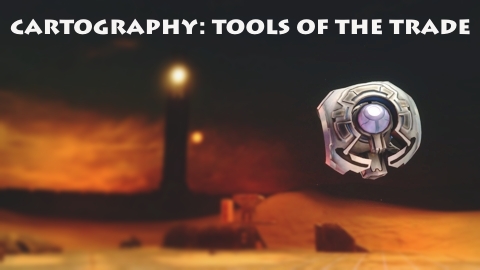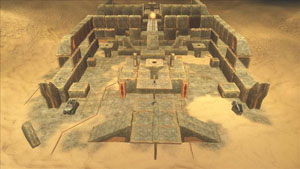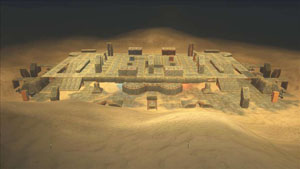Cartography: Tools of the Trade

Forge snuck up on me. What started out as a place for my daughter to drop tanks on her dad became the space where I spent an enormous chunk of my Halo playtime over the past year and a half. It gestated as a strange debug mode of sorts – Crackdown’s Keys to the City applied to Halo’s multiplayer – before emerging as a would-be map editor with the release of Sandbox, included in the Mythic Map Pack. Sandbox changed the way I think about and play Halo, as well as scratching a creative itch I wasn’t aware I had until its arrival. Sandbox also exposed the limitations of Forge as a creative tool, and highlighted the devotion of the Halo community through their successful efforts to overcome them.
As we sit on the eve of Halo: Reach’s release, I find myself looking back my own creative efforts using Forge, and looking ahead to how much of an impact the improved scale and UI of Reach’s iteration of Forge will help reshape the future of the maps we play.
I didn’t take Forge very seriously as a map editor until the release of Sandbox. Even after the release of Foundry, the object editing aspects of Forge were not something I spent much time with, because my preferred flavor of multiplayer involves Warthogs cruising around with the infantry. A smallish, dark warehouse didn’t get my creative juices flowing. Despite the warning the game provides when saving a map the first time, I mostly constructed swaths of fusion coils and admired the explosions. Sandbox took me from fusion coil technician to someone who put an inordinate amount of time into build and testing original map designs; I was fortunate enough to have one of my creations, Entrenched, appear in BTB matchmaking.

When it Sandbox was first announced, the sky bubble stood out as the most tantalizing of its three spaces; a massive blank canvas that could be transformed into maps of any shape and size. My imagination was lit up with the possibilities. Since BTB is my preferred flavor of Halo, I gravitated toward the large: a pair of castles in the sky, Banshees and Falcons on patrol in the open sky above. Between the bases was a multilayered field with enough room for Warthogs to patrol and infantry to snake through cover. The weekend before the Legendary maps were released, I had several designs sketched out on graph paper, ready to be implemented.
All of which came crashing down to earth upon actually building a map on Sandbox. A number of problems became immediately obvious, small and large. While the Forge interface worked well for placing weapons and spawn points, it was not well suited to placing and aligning dozens of pieces of geometry. Creating even rudimentary structures was slow and often cumbersome process, and much of my initial effort was spent simply working to line up objects properly. Even with the blue grid superimposed to aid with alignment, it was a challenge. The object physics more often than not were fighting against fine placement and adjustment. Sliding one object along the other could have unpredictable results, while grabbing an object to nudge it over a bit would simply lift it up and make me try again from scratch. It all added up to make some of the simplest tasks – making a ramp – slow and difficult. Mechanics which were well suited to Forge’s original design – spawn, weapon and objective placement – were far from ideal for editing geometry.
Also not apparent from the pre-release media and coverage of Sandbox was how the budget limitation impacted the size of the maps which could be constructed. The maps Halo 3 shipped with and the subsequent DLC maps all had a Forge budget, of course. But it was an almost abstract figure, seldom if ever reached because the maps were meant to be tweaked, not built. Foundry was within a space that accommodated a complex map within its confines comfortably. But while the sky bubble itself was vast and inviting, a functional map could occupy only occupy a tiny fraction of the space.
All of which meant my twin castles in the sky devolved quickly into something both simplistic and amateurish. As I struggled to finish the design within the confines of the budget, cover was left unplaced, vehicles – since they gobble up budget quickly – were pared back, and bases were simplified. What was left didn’t resemble my original idea at all, and worse, it wasn’t any fun to play on. The lone custom game to be played on it (dubbed Skyline) ended with my apologizing profusely for the abuse everyone suffered as a result. I was determined to get the fundaments of good map design better on my second outing, and that meant scaling back my ambitions dramatically to accommodate the budget. It would not be the first such concession to the limitations of the tool set.
I realized that building in the sky meant I had to devote most of the budget to creating the ground, which resulted in not building enough cover. That, or make a smaller map. Since I wanted to do a BTB map, that meant relocating to where the ground was already built: the sand basin. With terra firma to build on, I was free to spend less time building walk ways and more time settling on a layout. My goal was to operate well within the constraints of both the budget and minimize the thrash created by complex layouts. Doing so had a cost, though: the size and shape of the basin meant the design had to be of set dimensions. In all the maps I’ve played on the basin, through all the variety, they all share that same general size and shape. (And many were built using the full Forge budget, as well.)
Beyond scaling back the size of the map, I also needed to upgrade my Forging skill set. There had to be some ways to make the simple stuff easier, I told myself. It took exactly one trip to Forgehub to realize that not only had people found ways to overcome the struggles of precise object placement, they had found ways to create downright beautiful map designs in the process. Once again, the Halo community had come through to tackle a problem, solve it, and make the solution available to the rest of us. I spent an afternoon reading through their myriad guides and video tutorials on object placement, alignment and merging, and felt ready to tackle a new map design with renewed energy.
I learned two important methods from Forgehub: the use of blocks as an alignment tool for other blocks, and how to merge objects into one another. Object merging was a simple process – place one object, and set it to appear some time into a round. Then save, restart the game, and place another object overlapping the space the timed object occupied. And then, bam, the first would appear at the designated time, merged inside the other.
Between object merging, using an alignment tool and suspending objects in the air (by deleting the one below it), three crucial limitations of Forge were melted away. The community had began to craft maps that were not just functional, but had artistic touches, merging objects together to create elegant and often beautiful structures. I applied object merging in a more limited fashion: as a way to hid mistakes. On nearly every map I made, there were some places where two structures were intended to be identical in length, but one ended up slightly longer than the other. By using object merging, I could smoosh the end block into the one next to it, and mask the disparity. It was also handy for making small adjustments to the size or shape of structures – smaller steps and doors, ramps of different inclines, walkways that segued smoothly to other objects and ramps. The prefabricated shapes in the Forge palette were no longer the only shapes that would be found on maps. My maps became less bumpy, and a touch less chunky as a result.
The three basic forging techniques (suspending objects in the air, using a block to align structures, and object merging) all came with a price: time. Placing one chunk of geometry could often take several minutes of planning and execution. When stretched out over large areas, it meant hours could be spent building – and rebuilding – relatively small areas. Over time, I was finding myself making decisions based not only on ideas for the design of the map, but on how long it would take to execute them. I would employ object merging to shoehorn in tweaks where I didn’t want to go through the process of deleting and realigning entire sections of the map. But the most painful rebuilds involved maps that were not all placed on the ground.

I built two maps that made heavy use of vertical space, one in the sand basin, and one in the crypt. Both featured very large portions of the map elevated over the ground, with open space beneath them. The one on the sand basin – Sandstorm – featured a large secondary floor suspended directly over the main basin floor, to double the drivable surface area. And in both cases, I found myself compromising the design because I simply didn’t want to rebuild the entire structure. If I wanted to raise or lower the platforms, or shift them from side to side, it was a multi-hour investment. And so map design often had to take a back seat to simple logistics.
In retrospect, it’s telling that the my best received map was also the flattest and simplest to build, Entrenched. Choosing a level layout meant iterating on the core design was a painless process, as there was minimal merging and elevated structures. I could take feedback from play tests and my own ideas and incorporate them without having to make an enormous investment in time. It also makes the scores of incredible maps the Halo community created even more impressive: many of them represent enormous investments of time, talent and energy. The tool set was potent, but the price to entry was high. As a result, much of the Halo community never learned or had the patience to apply the methods necessary to bring out Forge’s full potential.
And that was what ultimately burned me out on Forge, after five completed and polished maps (and a dozen abandoned or unfinished): the sheer time and effort it was taking to translate an idea into a functional play space. Shortly before the Reach multiplayer beta, I gave up on the last of my designs, deciding that with Reach approaching, I would wait to see what the new iteration of the tool set had to offer. Surely there would be a better way to do things.
Was there ever.
Bungie’s Comic-Con reveal of Reach’s Forge was a perfect example of how simple solutions can change the nature of something entirely. As Shishka ticked off the improvements, it became increasingly clear that Bungie had addressed every one of the primary constraints to map construction.
The physics options alone directly address two of the three biggest obstacles to creating maps in Halo 3’s Forge. The ‘fixed’ setting means no one will ever spend time stacking objects in order to build an elevated structure again. And the ‘phased’ option removes both object merging and geo-merging (an advanced method of pushing Forge objects into the map geometry). Those additions alone will dramatically cut down on the time it takes to not only build a map, but more critically to iterate on a map design. Upper levels of maps can be built, nudged, and swapped out without affecting other parts of the map and without having to build an infrastructure around it so support the changes. It also meant I’d never be pulling an object alongside another, hoping the physics didn’t do something unpredictable.
Beyond the myriad UI changes – the coordinate nudges, fine placement tools – Bungie addressed some of Halo 3’s Forge issues with the forge palette itself. Creating enough floor space from the walls and blocks on Sandbox was a very time consuming process – any decently sized area was made up of a dozen or more pieces. In Forge World, there are several enormous floor pieces to select, each of which is the size of a few dozen of Sandbox’s largest walls. I laughed out loud when the Forge palette screenshot was released – between the physics models and those objects, my Halo 3 maps could have been built in a tiny fraction of the original time. What Bungie unveiled highlighted the stark difference between something built with custom maps in mind, and something that was not.
I actually built Sandstorm twice, because the top level needed a more efficient and less bumpy design. But doing so was a good 10-hour investment. Using Forge World’s giant floor pieces and the physics models, I could have done the entire rebuild in a few minutes. And beyond saving time on initial construction, the new tools will mean I can easily tweak and adjust the layout without any kind of major rebuild. Maps will not only be easier to make, but easier to iterate upon.
All of which will mean the players and communities who overcame the limitations to push Forge to its limit in Halo 3 are given enormous freedom to go further in Reach. While all those who couldn’t or wouldn’t make the time investment last time around will find those barriers removed. All in all the new Forge looks to be a classic example of Bungie’s design philosophy in action: they looked at what the community was doing with their game, and folded those ideas directly into their new game. It’s a powerful feedback loop of the creators helping the community, and vice versa.
The journey I went on after the release of Sandbox was replicated countless times over by the Halo community, one of creative aspirations scaling down to the reality imposed by a limited tool set. Despite the limitations and frustrations, Forge uncorked in me a creative desire I wasn’t aware I had. In looking back this last time at Forge’s outing in Halo 3, I find myself with a familiar feeling to Sandbox’s release: a strong impulse to create something ambitious and fun. All indications are, Reach’s version of Forge will blow the door off the creative energies the Halo community harbors, where Halo 3 merely opened the door a crack. We don’t yet know what the limits are in Reach’s Forge. It’s difficult to get a sense of the object limit or budget constraints without taking the time to push it there. What the limits are, and what the community will do to overcome them will be discovered shortly. But I’m looking forward to finding them out. I know I’ll be doing my part to kick the tires; I’ve got a stack of map designs sketched out and ready to go. There’s this big BTB map I’ve been working on. It’s set in the sky…
GhaleonEB
Article Errata
Community Cartographers – Entrenched
![]()

Great article… as someone who doesn’t use Forge (but appreciates the work involved) it’s great to see this perspective.
Really good site, keep on posting !